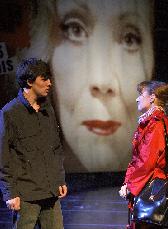SITE GUIDE
SEARCH
ADVERTISING AT CURTAINUP
REVIEWS
FEATURES
NEWS
Etcetera and
Short Term Listings
LISTINGS
Broadway
Off-Broadway
NYC Restaurants
BOOKS and CDs
OTHER PLACES
Berkshires
London
California
New Jersey
DC
Philadelphia
Elsewhere
QUOTES
TKTS
PLAYWRIGHTS' ALBUMS
LETTERS TO EDITOR
FILM
LINKS
MISCELLANEOUS
Free Updates
Masthead
Writing for Us
A CurtainUp  London Review
London Review
 London Review
London ReviewAll About My Mother
|
You're not a human being Lola, you're an epidemic — Manuela
|

Colin Morgan as Esteban and Lesley Manville as Manuela.
(Photo: Manuel Harlan)
|
Like the film, this is a humane elegy to maternal love which endures pain, death and grief, and follows in the tradition of strong female characters in Spanish drama. The fact that some of these strong females also used to be men is besides the point of their compassionate heroism.
The plot follows a bereaved, single mother's search for the father of her son in the wake of a tragic accident. Manuela (Lesley Manville) undertakes a journey in homage to her son's unfulfilled wish to know his father. This takes her to Barcelona, towards a confrontation with her buried past and to a series of idiosyncratic human encounters. One such encounter is with a famous, ageing stage diva Huma Rojo (Diana Rigg), who is hopelessly in thrall to her ballsy, drug-addled lover Nina (Charlotte Randle). Also featuring in Manuela's quest is Agrado, a transvestite with a loving heart and a wicked tongue (affectionately played with a lilting Welsh accent by Mark Gatiss), a young, compassionate nun Rosa (Joanne Froggatt) and the elusive transsexual Lola (Michael Schaeffer).
Full of theatrical references and literary characters with paradigmatic significance, it is easy to see why the film offers such suitable fodder for the stage. Lorca, Tennessee Williams and Joseph L. Mankiewicz all ground the story with a sense of artistic ancestry.
In general, the transition to the theatre is managed capably in the hands of Tom Cairns' performance-focussed direction. In fact, as this is a play about characters first and foremost, the strong cast does full justice to the story. Lesley Manville is particularly convincing with her steely fortitude in the face of adversity and absurdity. Moreover, the casting of Diana Rigg as a celebrated actress nicely dovetails the audience's consciousness of reality. It seems, for example, entirely plausible to see Diana Rigg's magnified face gracing a billboard, or her starring in the onstage snippets of Huma's touring production of "A Streetcar Named Desire". Samuel Adamson's adaptation is intelligent and naturalistic, and sacrifices neither the moving force nor the emotional subtlety of the original.
Apart from names, there is little sense that the play is set in Spain. Also, the design undermines the enterprise somewhat. The glossy, reflective floor adds visual emphasis to the fact that the audience are witnessing a performance rather than reality. The front of the stage is extended but unused, with a stylish but distancing effect. This weakens what is most unique to theatre and what ought to be a strong advantage: the live immediacy of the acting.
This production is expertly handled and excellent within itself although ultimately safe and unchallenging. In translating a great film, some things are lost and not all that much is gained. And without an artistic raison d'être, you can't help but ask why they should venture upon this adaptation, except for ticket sales. In spite of these cynical considerations, Pedro Almodovar's empathetic genius is always a joy to behold in any medium.
|
ALL ABOUT MY MOTHER
Based on the film by Pedro Almodovar Adapted by Samuel Adamson Directed by Tom Cairns Starring: Diana Rigg, Lesley Manville, Mark Gatiss With: Colin Morgan, Eleanor Bron, Bradley Freegard, Joanne Froggatt, Robert Galas, Lucy-Anne Holmes, Eileen Nicholas, Yvonne O'Grady, Charlotte Randle, Michael Schaeffer Design: Hildegard Bechtler Lighting: Bruno Poet Sound: Christopher Shutt Music: Alberto Iglesias Costume Design: Moritz Junge Stage Score: Ben and Max Ringham Running time: Two and a half hours with one interval Box Office: 0870 060 6628 Booking to 24th November 2007 Reviewed by Charlotte Loveridge based on 5th Septemner 2007 performance at the Old Vic, Waterloo Road, SE1 8NB (Tube: Waterloo) |
|
London Theatre Tickets Lion King Tickets Billy Elliot Tickets Mary Poppins Tickets Mamma Mia Tickets We Will Rock You Tickets Theatre Tickets |




